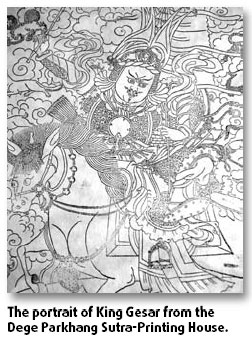|

|
| Thirty years of devoted research has made Jampel Gyatso an expert of Tibetan epic of King Gesar. Wang Jing |
A huge wall carpet, depicting the grandeur of the Potala Palace, has pride of place in the sitting room of Jampel Gyatso's apartment in northern Beijing. Facing this carpet is a portrait of the most beloved legendary hero of the Tibetan people, King Gesar, whose tales have been sung by ballad singers for more than 1,000 years.
As the first Tibetan associate research fellow with the Institute of Ethnic Literature in the Chinese Academy of Social Sciences, Jampel took up the mission of studying King Gesar in 1981, after he had witnessed the National People's Congress in session for 25 years as a senior translator and introduced classics by Mao Zedong and Karl Marx to his Tibetan compatriots.
Thirty years later, Jampel has become a chief expert on King Gesar. As the disciplinary leader of King Gesar, he has led his team to make great achievements and won international reputation for his motherland in the academic sphere.
Even though his original idea after leaving behind his career as a translator was to study contemporary literature while writing novels - he had finally published the novel Kelzang Metog after a 20-year delay - Jampel wasn't very surprised about his new mission.
He had grown up listening to the tales featuring colorful metaphors and vivid imagination. Elders at his hometown say that when King Gesar passed by Batang to conquer a monster, the King threw a gigantic boulder to test his strength, leaving a pair of deep, huge footprints. All the locals believe that it was King Gesar who blessed the area with bumper harvests.
The portrait of King Gesar at Jampel's home was a gift from the Dege Parkhang Sutra-Printing House in the hometown of King Gesar in Dege county of Garze Tibetan prefecture, Sichuan province.
It is made from a wooden mould some 200 years old - one of the oldest in the world, Jampel says.
 Five years into retirement, Jampel is still working on a 40-volume condensed edition of the epic in Tibetan. When it is published in 2011, Jampel hopes more people will know of the wonderful tales of King Gesar, and recognize it as one of the brightest jewels in Tibetan literature.
Five years into retirement, Jampel is still working on a 40-volume condensed edition of the epic in Tibetan. When it is published in 2011, Jampel hopes more people will know of the wonderful tales of King Gesar, and recognize it as one of the brightest jewels in Tibetan literature.
There are three basic periods of King Gesar's life: the birth of the hero, the wars he waged against monsters, and his return to heaven. Described as a combination of god, dragon and nian (vicious god), King Gesar conquered evils with his gallant followers and brought happiness to the common people.
The tales of King Gesar had emerged before the 6th century, as the slavery system took shape in Tibet. Its structure was completed before the 13th century, with many monks of the Nyingma Sect of Tibetan Buddhism collecting and spreading the hand-written scripts.
Western researchers had discovered King Gesar in the 18th century and the study of the epic, named Gesarology, blossomed in the 1960s.
The Chinese government issued the first document about preserving King Gesar in 1958. Hundreds of Chinese researchers have devoted themselves to Gesarology, which has gained national funding as a chief academic project over the past 30 years.
"The move is unprecedented in the history of Tibetan culture and is rare in the history of China's multinational cultures," says Jampel proudly.
After visiting Tibetan areas and interviewing ballad singers of King Gesar, Jampel published China's first book on Gesarology - Studies of King Gesar. As a landmark in China's academic fields, it put an end to the history that China didn't have any books on epics.
From more than 150 ballad singers, Chinese researchers have collected more than 120 volumes of the epic, reaching more than 20 million words in 1 million lines. It you add the Greek epics - the Iliad and Odyssey, and the Indian epics - the Ramayana and Mahabharata, their total length is much shorter than that of King Gesar.
"Overseas researchers had a misunderstanding that Tibetan culture was a religious culture and that China had no epics. Our studies of King Gesar have changed this," Jampel says.
During his many trips abroad, Jampel strived to call world attention to Chinese studies of King Gesar. Part of his dream was realized in October 2001, when the United Nations Educational, Scientific and Cultural Organization listed the millennium of King Gesar as one of the anniversaries to be marked by its member countries in 2002 and 2003.
Over the years, 4 million copies of King Gesar in Tibetan have been published, Jampel says.
"The Tibetan population is about 5 million, which means that we've printed one copy of King Gesar for each grownup Tibetan. This is the biggest publication of a book on Tibetan culture in China since 1949," says Jampel.
(China Daily March 30, 2009)